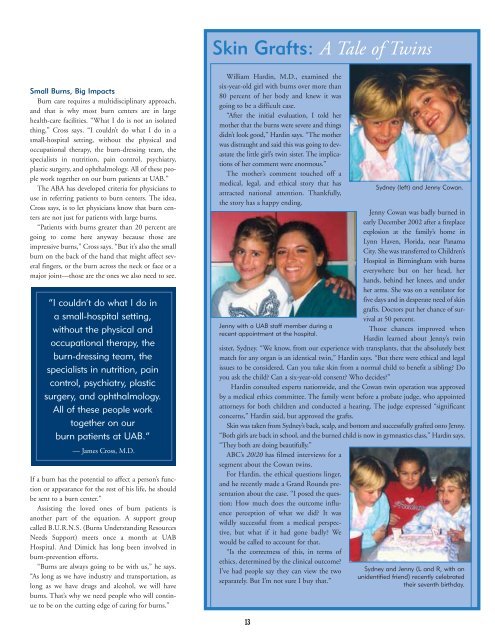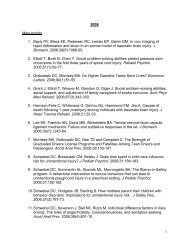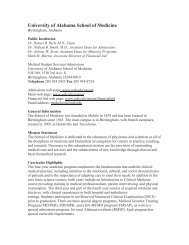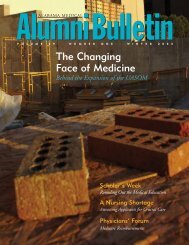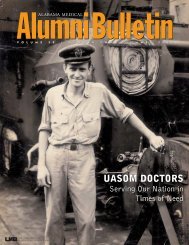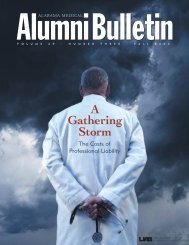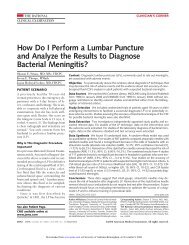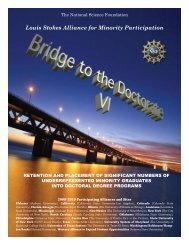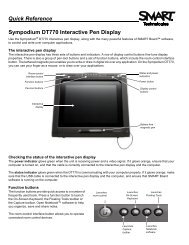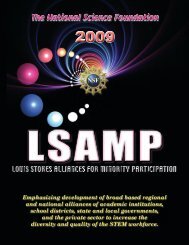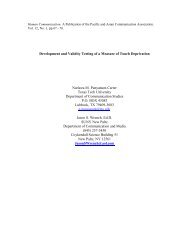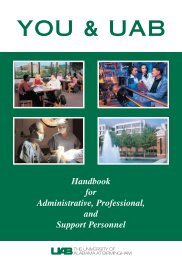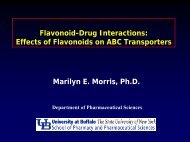the pursuit of parkinson's - The University of Alabama at Birmingham
the pursuit of parkinson's - The University of Alabama at Birmingham
the pursuit of parkinson's - The University of Alabama at Birmingham
You also want an ePaper? Increase the reach of your titles
YUMPU automatically turns print PDFs into web optimized ePapers that Google loves.
Skin Grafts: A Tale <strong>of</strong> Twins<br />
Small Burns, Big Impacts<br />
Burn care requires a multidisciplinary approach,<br />
and th<strong>at</strong> is why most burn centers are in large<br />
health-care facilities. “Wh<strong>at</strong> I do is not an isol<strong>at</strong>ed<br />
thing,” Cross says. “I couldn’t do wh<strong>at</strong> I do in a<br />
small-hospital setting, without <strong>the</strong> physical and<br />
occup<strong>at</strong>ional <strong>the</strong>rapy, <strong>the</strong> burn-dressing team, <strong>the</strong><br />
specialists in nutrition, pain control, psychi<strong>at</strong>ry,<br />
plastic surgery, and ophthalmology. All <strong>of</strong> <strong>the</strong>se people<br />
work toge<strong>the</strong>r on our burn p<strong>at</strong>ients <strong>at</strong> UAB.”<br />
<strong>The</strong> ABA has developed criteria for physicians to<br />
use in referring p<strong>at</strong>ients to burn centers. <strong>The</strong> idea,<br />
Cross says, is to let physicians know th<strong>at</strong> burn centers<br />
are not just for p<strong>at</strong>ients with large burns.<br />
“P<strong>at</strong>ients with burns gre<strong>at</strong>er than 20 percent are<br />
going to come here anyway because those are<br />
impressive burns,” Cross says. “But it’s also <strong>the</strong> small<br />
burn on <strong>the</strong> back <strong>of</strong> <strong>the</strong> hand th<strong>at</strong> might affect several<br />
fingers, or <strong>the</strong> burn across <strong>the</strong> neck or face or a<br />
major joint—those are <strong>the</strong> ones we also need to see.<br />
“I couldn’t do wh<strong>at</strong> I do in<br />
a small-hospital setting,<br />
without <strong>the</strong> physical and<br />
occup<strong>at</strong>ional <strong>the</strong>rapy, <strong>the</strong><br />
burn-dressing team, <strong>the</strong><br />
specialists in nutrition, pain<br />
control, psychi<strong>at</strong>ry, plastic<br />
surgery, and ophthalmology.<br />
All <strong>of</strong> <strong>the</strong>se people work<br />
toge<strong>the</strong>r on our<br />
burn p<strong>at</strong>ients <strong>at</strong> UAB.”<br />
— James Cross, M.D.<br />
If a burn has <strong>the</strong> potential to affect a person’s function<br />
or appearance for <strong>the</strong> rest <strong>of</strong> his life, he should<br />
be sent to a burn center.”<br />
Assisting <strong>the</strong> loved ones <strong>of</strong> burn p<strong>at</strong>ients is<br />
ano<strong>the</strong>r part <strong>of</strong> <strong>the</strong> equ<strong>at</strong>ion. A support group<br />
called B.U.R.N.S. (Burns Understanding Resources<br />
Needs Support) meets once a month <strong>at</strong> UAB<br />
Hospital. And Dimick has long been involved in<br />
burn-prevention efforts.<br />
“Burns are always going to be with us,” he says.<br />
“As long as we have industry and transport<strong>at</strong>ion, as<br />
long as we have drugs and alcohol, we will have<br />
burns. Th<strong>at</strong>’s why we need people who will continue<br />
to be on <strong>the</strong> cutting edge <strong>of</strong> caring for burns.”<br />
William Hardin, M.D., examined <strong>the</strong><br />
six-year-old girl with burns over more than<br />
80 percent <strong>of</strong> her body and knew it was<br />
going to be a difficult case.<br />
“After <strong>the</strong> initial evalu<strong>at</strong>ion, I told her<br />
mo<strong>the</strong>r th<strong>at</strong> <strong>the</strong> burns were severe and things<br />
didn’t look good,” Hardin says. “<strong>The</strong> mo<strong>the</strong>r<br />
was distraught and said this was going to devast<strong>at</strong>e<br />
<strong>the</strong> little girl’s twin sister. <strong>The</strong> implic<strong>at</strong>ions<br />
<strong>of</strong> her comment were enormous.”<br />
<strong>The</strong> mo<strong>the</strong>r’s comment touched <strong>of</strong>f a<br />
medical, legal, and ethical story th<strong>at</strong> has<br />
<strong>at</strong>tracted n<strong>at</strong>ional <strong>at</strong>tention. Thankfully,<br />
<strong>the</strong> story has a happy ending.<br />
Jenny with a UAB staff member during a<br />
recent appointment <strong>at</strong> <strong>the</strong> hospital.<br />
Jenny Cowan was badly burned in<br />
early December 2002 after a fireplace<br />
explosion <strong>at</strong> <strong>the</strong> family’s home in<br />
Lynn Haven, Florida, near Panama<br />
City. She was transferred to Children’s<br />
Hospital in <strong>Birmingham</strong> with burns<br />
everywhere but on her head, her<br />
hands, behind her knees, and under<br />
her arms. She was on a ventil<strong>at</strong>or for<br />
five days and in desper<strong>at</strong>e need <strong>of</strong> skin<br />
grafts. Doctors put her chance <strong>of</strong> survival<br />
<strong>at</strong> 50 percent.<br />
Those chances improved when<br />
Hardin learned about Jenny’s twin<br />
sister, Sydney. “We know, from our experience with transplants, th<strong>at</strong> <strong>the</strong> absolutely best<br />
m<strong>at</strong>ch for any organ is an identical twin,” Hardin says. “But <strong>the</strong>re were ethical and legal<br />
issues to be considered. Can you take skin from a normal child to benefit a sibling? Do<br />
you ask <strong>the</strong> child? Can a six-year-old consent? Who decides?”<br />
Hardin consulted experts n<strong>at</strong>ionwide, and <strong>the</strong> Cowan twin oper<strong>at</strong>ion was approved<br />
by a medical ethics committee. <strong>The</strong> family went before a prob<strong>at</strong>e judge, who appointed<br />
<strong>at</strong>torneys for both children and conducted a hearing. <strong>The</strong> judge expressed “significant<br />
concerns,” Hardin said, but approved <strong>the</strong> grafts.<br />
Skin was taken from Sydney’s back, scalp, and bottom and successfully grafted onto Jenny.<br />
“Both girls are back in school, and <strong>the</strong> burned child is now in gymnastics class,” Hardin says.<br />
“<strong>The</strong>y both are doing beautifully.”<br />
ABC’s 20/20 has filmed interviews for a<br />
segment about <strong>the</strong> Cowan twins.<br />
For Hardin, <strong>the</strong> ethical questions linger,<br />
and he recently made a Grand Rounds present<strong>at</strong>ion<br />
about <strong>the</strong> case. “I posed <strong>the</strong> question:<br />
How much does <strong>the</strong> outcome influence<br />
perception <strong>of</strong> wh<strong>at</strong> we did? It was<br />
wildly successful from a medical perspective,<br />
but wh<strong>at</strong> if it had gone badly? We<br />
would be called to account for th<strong>at</strong>.<br />
“Is <strong>the</strong> correctness <strong>of</strong> this, in terms <strong>of</strong><br />
ethics, determined by <strong>the</strong> clinical outcome?<br />
I’ve had people say <strong>the</strong>y can view <strong>the</strong> two<br />
separ<strong>at</strong>ely. But I’m not sure I buy th<strong>at</strong>.”<br />
Sydney (left) and Jenny Cowan.<br />
Sydney and Jenny (L and R, with an<br />
unidentified friend) recently celebr<strong>at</strong>ed<br />
<strong>the</strong>ir seventh birthday.<br />
13


